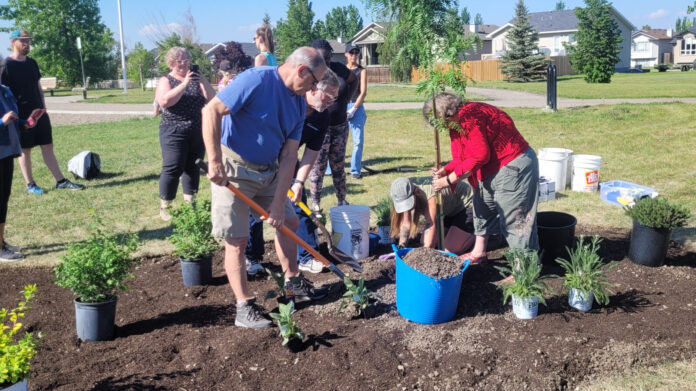To get an early start on Environment Week, which officially kicks off Sunday, volunteers planted a new drought-resistant garden at Tartan Park in west Lethbridge on Friday.
“We’re kicking Environment Week off a couple of days early with some work on our Living Cities project,” says Environment Lethbridge Executive Director Kathleen Sheppard.
Environment Week runs in partnership with the City of Lethbridge from June 1-7.
The garden features more than a dozen different species of native and drought-tolerant trees, shrubs and plants.
According to Sheppard, the Tartan Park project is intended to demonstrate the possibilities of drought-resilient landscaping in Lethbridge. “As our summers get hotter and drier, it’s important to think about alternative plants that use less water.”
“We hope this project will not only add aesthetic value to Tartan Park, but will inspire homeowners to explore different landscaping options in their own yards,” adds Sheppard. “Every year, we try to showcase the diversity of our local environment.”
Using drought-tolerant plants doesn’t mean you have to use a lot of rocks and cactuses, Sheppard explains. “There’s a lot of great native plants to enhance your landscaping with.”
A drought-tolerant plant will take about a year where they will need a little extra water to grow into their space, says Sheppard. “Once they’re established, they will use a lot less water than plants that are not native to this area or just need more water overall to grow.”
“They’ll resist drought, water shortages and they won’t take as much water throughout the year.”
With water conservation on everyone’s mind, Sheppard notes, the Tartan Park garden is a way to raise awareness.
Next week, there will be plenty of activities and events happening to celebrate Environment Week, including birding, tree planting and a recycling roundup.
Sheppard adds Environment Lethbridge has also partnered with Fleetwood-Bawden and Winston Churchill schools to add native plants to some of their plantings in the fall.
Southern Alberta weather is increasingly hot and dry, Sheppard says, so that means if people want to have landscaping around their homes that doesn’t consume too much water, “we need to start looking to these alternatives.”
“I think a lot of people are increasingly thinking about how much water they put on their lawn, trees and shrubs.”







